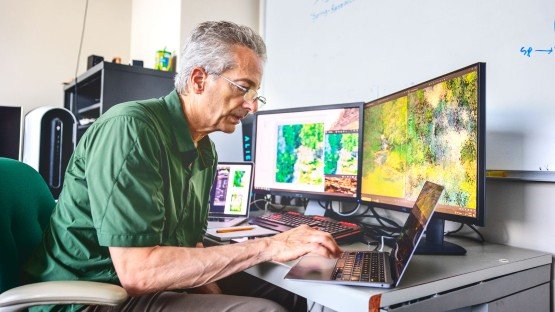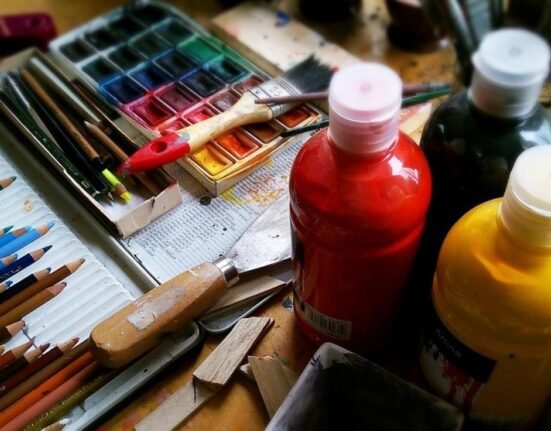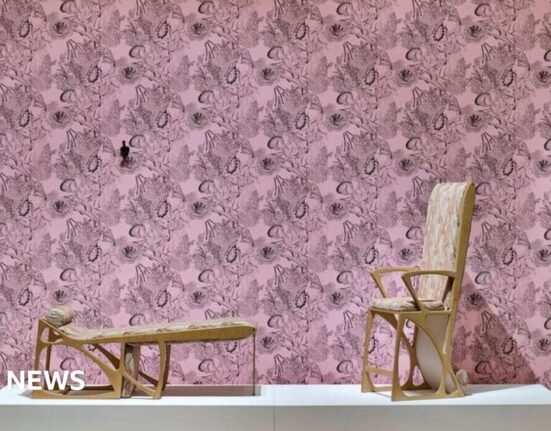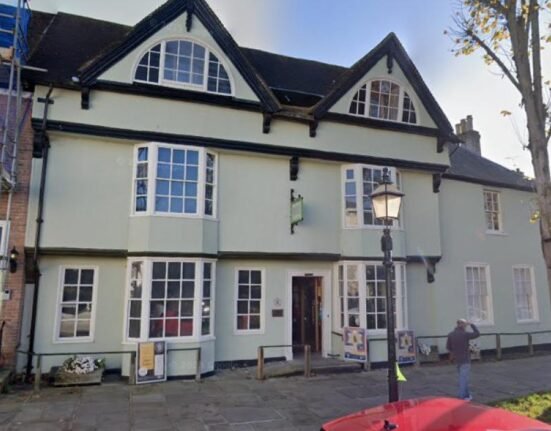When Daniel Ambrosi ’80, B.Arch. ’82, M.S. ’85, walks along an Ithaca-area trail, he’s remembering previous visits to the same place, comparing new photos to those he took years ago – and imagining what artificial intelligence will do with his works once he uploads them.
A digital artist who constructs panoramic prints that are enhanced by AI, Ambrosi returned to Cornell this summer for a six-week artist residency in the Ann S. Bowers College of Computing and Information Science’s Department of Computer Graphics, with the aim of creating a new batch of large-scale artworks.
As a student, he was inspired by the region’s natural beauty and worked with Don Greenberg ’55, Ph.D. ’68, the Jacob Gould Schurman Professor of Computer Graphics in the College of Architecture, Art and Planning and in Bowers CIS. The residency reunited him with Greenberg, his former mentor and a legendary computer graphics pioneer who is still actively teaching.
“Not many faculty have the opportunity to work with their best technical and innovative students 40 years after they graduate,” Greenberg said at the start of the summer. “I am greatly looking forward to how Daniel is able to merge two separate but related disciplines.”
Throughout the residency, Ambrosi also collaborated with Alex Kwan, Ph.D. ’09, associate professor in the Meinig School of Biomedical Engineering in Cornell Engineering, whose research in psychedelic neuroscience has informed Ambrosi’s approach.
Psychedelics are now being studied for their therapeutic potential in treating mental illnesses such as depression. Among Kwan’s major discoveries in recent years: that a single dose of psilocybin can lead to long-lasting rewiring of neural connections.
“I was particularly thrilled to see how our work has inspired Daniel’s art,” Kwan said. “For example, one of his new pieces was inspired by our psilocybin study; its dream-like imagery includes elements that reach out and make connections, just like neurons.”
DeepDream, the customized AI engine Ambrosi uses, is not an image generator –though he has nothing against them.
“DeepDream was not created to make art, and it was not trained on other people’s art,” he said. “It was part of a computer vision system tasked with image classification. It’s trying to make sense of what it sees. In my case, it’s seeing my photography.”
Ambrosi said that one of the remarkable things about his AI partner is that, like humans, it seems to exhibit “pareidolia” – the ability to perceive order in random imagery.
“When we see a rabbit in the clouds, that’s pareidolia at work,” he said. “When we dream, we hallucinate, we imagine; we see things that aren’t really there. The AI also seems to be exhibiting that behavior.”
For Ambrosi, this creative process is a collaboration: a 50-50, human-AI workflow. “It’s not sentient, obviously,” he said, “but it feels like a partner.”
Ambrosi’s creations are typically large-scale, backlit fabric artworks, measuring up to 16 feet wide by eight feet high.
His first exhibit, “Dreamscapes,” fittingly debuted at a major conference for AI developers and researchers, in 2016 in San Jose, California.
Despite all the technology involved, Ambrosi said he’s most strongly influenced by the grand-format landscape artists spanning the past 400 years, such as Claude Lorrain, Frederic Church and David Hockney – and by 18th-century English landscape architect and gardener Lancelot “Capability” Brown.
“They’re incredibly detailed, scientifically accurate, luminous landscapes where light reigns supreme,” he said. “My paints and brushes happen to be cameras, computers and AI.”
Joe Wilensky is a senior editor at Cornellians.







